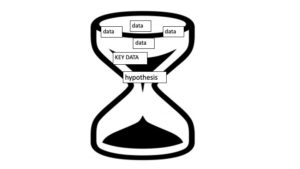Specific Aims Part III – the Hypothesis (part 1)
As Mary Poppins says, let’s start at the very beginning. What is your hypothesis? Since the entire grant revolves around this one statement, it’s important that put some thought into generating a good one. What is a good hypothesis? One that is clear, testable, provable, and supported by rationale (aka your preliminary data). We’ll go into the specifics of how to write a good hypothesis in part 2 of this post, for now I want to make sure you have one. Chances are, if this is your first grant, or first grant on this topic, you haven’t written a hypothesis yet. We have vague hypotheses in our heads as we do experiments, but usually we don’t write these down. Now’s the time to get those visions of sugarplums out of your head and onto paper.
Let’s go through a couple examples of hypotheses to get a better sense of what I’m talking about. This morning when I woke up, the last piece of chocolate cake was gone. There was a plate and fork with cake crumbs in the sink. My son was in bed when I went to sleep but my husband was up watching TV. My husband really likes chocolate cake. In addition, my son is a teenager, and once asleep he does not get up (sometimes for days). Based on my husband’s love of chocolate cake, the fact that he was awake when I went to bed, and my son’s sleeping habits, I hypothesize that my husband ate the cake. When questioned, he denies it, saying the dishes were in the sink when he went to bed. Fingerprinting of the fork and plate revealed all 3 family members plus the dog had touched the fork and plate. In the end, hard to prove that my husband ate the cake. Criminal lawyers face this challenge daily. My hypothesis was clear, testable, and supported by rationale. However, it was not provable.
Here’s another one. My dog is super skinny. He’s always been thin but he’s lost more weight recently. In addition to his weight loss, there are these weird bits of stuff that look like rice surrounding his favorite dog bed. Google informs me that dried pieces of flat, rice-like looking stuff might be dried tape worm segments. Based on the rice-like segments and his weight loss, I hypothesize that my dog has tapeworms. This hypothesis is testable and provable. His stool can be examined for worms (yay) or the rice-like bits can be taken to the vet for assessment. I’m kind of cheap, so I’ll just skip all that diagnostic stuff and treat him but that’s another story.

The “hourglass” of your hypothesis.
The hypothesis is analogous to the neck of an hourglass. You sift through your preliminary data and choose the data (rationale) that best support your hypothesis. This is the data that will go into your grant. Data most important to supporting your hypothesis approaches the neck of this hourglass – this data go on the specific aims page. If there is data missing, now’s the time to get it. Developing your hypothesis sooner rather than later will ensure that you have the preliminary data necessary to support it.
Flowing out from your hypothesis is the approach. Your specific aims, sub-aims, etc. At the expense of sounding like Captain Obvious, it’s important that your aims truly address your hypothesis. We’ll go into this in more detail in the next post. Once you have your aims, think about how you’ll carry out each aim. What techniques will you use? Do you need a collaborator or consultant? New equipment? Thinking about your approach ahead of time will make sure you fill in the gap between what you can do and what you can’t. The best approach will fall short if reviewers don’t believe that you can do the work. The convincing is on you. Planning your approach early will make sure you have time to contact potential collaborators/co-investigators who have expertise in a field or technique new to you. If the technique is one your lab can do but has not done yet, a pilot experiment demonstrating this technique is “up and running” in your lab will show reviewers that you can do the work. Let me give you an example. I recently wrote a grant that required using immunoprecipitation. For those not familiar with this technique, it involves using an antibody to capture a protein of interest from cell or tissue preparations. This technique is not difficult, but not all antibodies are good for immunoprecipitating. Plus, it’s one of those techniques that is mechanistically easy but can require the sacrifice of a small chicken to get it to work. Because I had a specific antibody that I wanted to use for immunoprecipitating, it was important to demonstrate that the technique worked with this antibody. In addition, it was good to show that our lab had experience with this technique. I didn’t have a lot of time (clearly not following my own advice) so I bought a kit and after a few tries got the immunoprecipitation to work. I added the figure a few days before the grant went out. I was lucky, though, and was close to not having this data. The moral of this story is don’t do as I do, but do as I say – plan ahead.
On that note, plan ahead to read part 2 of this post on generating a testable hypothesis.
Further reading:
Part I of the SA page series, setting up the problem (paragraph 1)
https://edgeforscholars.org/specific-aims-part-1-the-problem/
Part II of the SA page series, presenting your solution (paragraph 2)
https://edgeforscholars.org/specific-aims-part-ii-the-solution/
Writing for Science by Josh Schimel, especially Chapter 14 which includes fuzzy hypotheses
Home Page Image
Creator: Ana Municio
Source: http://unsplash.com






0 Comments